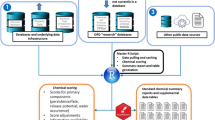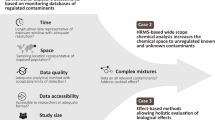Abstract
The Minnesota Children's Pesticide Exposure Study (MNCPES) of the National Human Exposure Assessment Survey (NHEXAS) was conducted in Minnesota to evaluate children's pesticide exposure. This study complements and extends the populations and chemicals included in the NHEXAS Region V study. One of the goals of the study was to test protocols for acquiring exposure measurements and developing databases for use in exposure models and assessments. Analysis of the data quality is one element in assessing the performance of the collection and analysis protocols used in this study. Data quality information must also be available to investigators to guide analysis of the study data. During the planning phase of MNCPES, quality assurance (QA) goals were established for precision, accuracy, and quantification limits. The data quality was assessed against these goals. The assessment is complex. First, data are not available for all analytes and media sampled. In addition, several laboratories were responsible for the analysis of the collected samples. Each laboratory provided data according to their standard operating procedures (SOPs) and protocols. Detection limits were authenticated for each analyte in each sample type. The approach used to calculate detection limits varied across the different analytical methods. The analytical methods for pesticides in air, food, hand rinses, dust wipe and urine were sufficiently sensitive and met the QA goals, with very few exceptions. This was also true for polynuclear aromatic hydrocarbons (PAHs) in air and food. The analytical methods for drinking water and beverages had very low detection limits; however, there were very little measurable data for these samples. The collection and analysis methods for pesticides in surface press samples and soil, and for PAHs in dust wipes were not sufficiently sensitive. Accuracy was assessed primarily as recovery from field controls. The results were good for pesticides and PAHs in air (75–125% recovery). Recovery was lower (<75%) for pesticides in drinking water and beverages. The recovery of pesticides from hand rinses met QA goals (75–100%), but surface press samples showed lower recovery (50–70%). Analysis by gas chromatography-mass spectrometry (GC–MS) did not confirm the presence of atrazine and other pesticides in hand rinse and surface press samples that had been detected by GC-ECD, but instead GC–MS confirmed background interferences. Assessment of the precision of sample collection and analysis is based on the percent relative standard deviation (%RSD) between the results for duplicate samples. Data are available only for pesticides and PAHs in air. Precision was good (<20% RSD) for analytes with measurable data. There were a few analytes with %RSD >20%, but the number of data pairs was very small in these cases. Precision for instrumental analysis of food sample extracts was excellent, with the median %RSD < 20 for all measurable pesticides. The median %RSD for the analysis of replicate aliquots of food from the same sample composite was considerably higher, indicating the potential for inhomogeneity of food homogenates.
This is a preview of subscription content, access via your institution
Access options
Subscribe to this journal
Receive 6 print issues and online access
$259.00 per year
only $43.17 per issue
Buy this article
- Purchase on Springer Link
- Instant access to full article PDF
Prices may be subject to local taxes which are calculated during checkout
Similar content being viewed by others
Notes
QSIP document also contains a full description of the analytical protocols and quality control and assurance procedures employed. It is available from the US EPA, NERL (MC-HERB), PO Box 93478, Las Vegas, NV 89193, USA.
Abbreviations
- GC-ECD:
-
gas chromatography-electron capture detection
- GC–MS:
-
gas chromatography–mass spectrometry
- FC:
-
field control
- FSD:
-
full-scale deflection
- K-D:
-
Kuderna-Danish
- LOQ:
-
limit of quantification
- LWW:
-
Lioy–Wainman–Weisel sampler
- MC:
-
method control
- MDL:
-
method detection limit
- MNCPES:
-
Minnesota Children's Pesticide Exposure Study
- NHEXAS:
-
National Human Exposure Assessment Survey
- NIST:
-
National Institute of Science and Technology
- NOPES:
-
Nonoccupational Pesticide Exposure Study
- %CV:
-
coefficient of variation in percent
- PAHs:
-
polynuclear aromatic hydrocarbons
- PFT:
-
perfluorotoluene
- QA:
-
Quality assurance
- QC:
-
quality control
- QL:
-
quantification limit
- QSIP:
-
Quality Systems Implementation Plan
- SOPs:
-
standard operating procedures
- SRM:
-
standard reference materials
- RSD:
-
relative standard deviation
- TEAM:
-
Total Exposure and Assessment Methodology
- US EPA:
-
United States Environmental Protection Agency.
References
Adgate J.L., Clayton C.A., Quackenboss J.J., Thomas K.W., Whitmore R.W., Pellizzari E.D., Lioy P.J., Shubat P., Stroebel C., Freeman N.C.G., and Sexton K. Measurement of multi-pollutant and multi-pathway exposures in a probability-based sample of children: practical strategies for effective field studies. J Expos Anal Environ Epidemiol 2000: 10(6/2): 650–661.
Beeson M.D., Driskell W.J., and Barr D.B. Isotope dilution high-performance liquid chromatography/tandem mass spectrometry method for quantifying urinary metabolites of atrazine, malathion, and 2,4-dichlorophenoxyacetic acid. Anal Chem 1999: 71: 3526–3530.
Hartwell T.D., Pellizzari E.D., Perritt R.L., Whitmore R.W., Zelon H.S., Sheldon L.S., Sparacino C.M., and Wallace L. Results from the Total Exposure Assessment Methodology (TEAM) Study in selected communities in Northern and Southern California. Atmos Environ 1987: 21: 1995.
Hill Jr. R.H., Shealy D.B., Head S.L., Alley C.C., Bailey S.L., Gregg M., Baker S.E., and Needham L.L. Determination of pesticide metabolites in human urine using isotope dilution technique and tandem mass spectrometry. J Anal Toxicol 1995: 19: 323–329.
Pellizzari E.D., Smith D.J., Clayton C.A., Michael, L.C., and Quackenboss J.J. An assessment of the data quality for NHEXAS—Part I: exposure to metals and volatile organic chemicals in Region 5. J Expos Anal Environ Epidemiol 2001: 112: 140–154.
Quackenboss J.J., Pellizzari E.D., Shubat P., Whtimore R.W., Adgate J.L., Thomas K.W., Freeman N.C.G., Stroebel C., Lioy P.J., Clayton A.C., and Sexton K. Design strategy for assessing multi-pathway exposure for children: the Minnesota Children's Pesticide Exposure Study (MNCPES). J Expos Anal Environ Epidemiol 2000: 102: 145–158.
US FDA. Analytical Limits of Quantitation, Pesticide Analytical Manual (PAM) Vol., I, Section 105, 3rd ed, 1994.
Wallace L.A., Pellizzari E.D., Hartwell T.D., Sparacino C., Whitmore R., Sheldon L., Zelon H., and Perritt R. The TEAM Study: personal exposures to toxic substances in air, drinking water and breath of 400 residents of New Jersey, North Carolina, and North Dakota. Environ Res 1987: 43: 290–307.
Whitmore R.W., Immerman F.W., Camann D.E., Bond A.E., Lewis R.G., and Schuam J.L. Non-occupational exposures to pesticides for residents of two U.S. Cities. Arch Environ Contam Toxicol 1994: 26: 47–59.
Acknowledgements
We thank the participating laboratories for providing their adroit assistance in analyzing NHEXAS samples. The US Environmental Protection Agency (EPA), through its Office of Research and Development (ORD), funded and performed the research under Cooperative Agreement CR821902-01-0 and the analysis of results under Contract Number 68-D-99-008. This manuscript has been peer reviewed by EPA and approved for publication. Mention of trade names or commercial products does not constitute endorsement or recommendation for use.
Author information
Authors and Affiliations
Corresponding author
Rights and permissions
About this article
Cite this article
Pellizzari, E., Smith, D., Andrew Clayton, C. et al. Assessment of data quality for the NHEXAS — Part II: Minnesota children's pesticide exposure study (MNCPES). J Expo Sci Environ Epidemiol 13, 465–479 (2003). https://doi.org/10.1038/sj.jea.7500315
Received:
Accepted:
Published:
Issue Date:
DOI: https://doi.org/10.1038/sj.jea.7500315
Keywords
This article is cited by
-
Comparison of global positioning system (GPS) tracking and parent-report diaries to characterize children's time–location patterns
Journal of Exposure Science & Environmental Epidemiology (2007)
-
Rapid detection of atrazine and its metabolite in raw urine by extractive electrospray ionization mass spectrometry
Metabolomics (2007)



